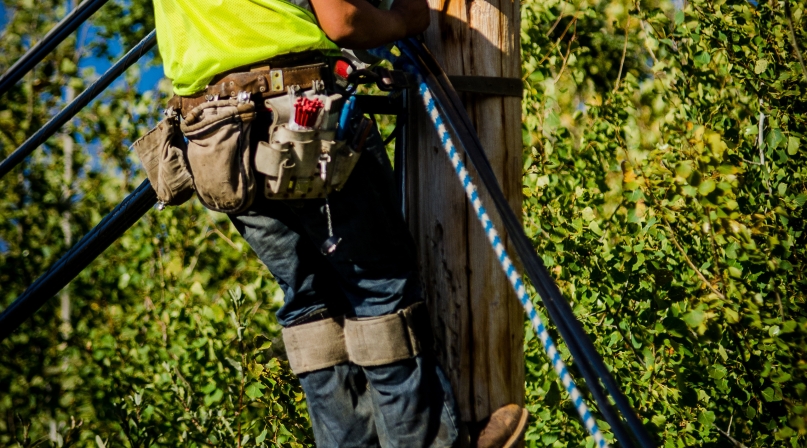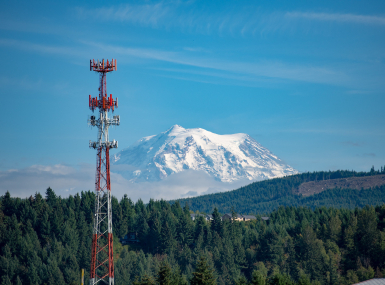County becomes own broadband provider
Upcoming Events
Related News

A contract employee in Lake County, Minn. attaches fiber-optic cable that comprises the above-ground portion of Lake Connections, a county-owned broadband provider. The majority of the system is underground. Photo courtesy of Lake County, Minn.County-owned, privately-operated company brings broadband to rural Minn. county
One Lake County, Minn. woman no longer has to wait until Super Bowl Sunday to e-file her income tax return — since that was when most people were watching the game and weren’t online.
And peace has been restored to county Commissioner Rick Goutermont’s household. “Me and my daughter used to arm wrestle over if she was going to be watching Netflix, I couldn’t go on the computer. Now she’s streaming on her phone and … on the TV and I’m on my computer, and there’s never any conflict at all.”
Those are two examples county officials give of life after Lake Connections, a county-owned, privately operated company that has buried or strung 1,200 miles of fiber-optic cable throughout this rural northern Minnesota county. It’s given the county some of the fastest, most reliable internet access in the state, perhaps the nation, according to Commission Chairman Rich Sve.
“It gets to the point of what counties do,” he said of getting into the telecommunications business. “What is the need of our people? And this is a perfect example, because for me it’s not that you are able to get on your Facebook or you’re able to play a game. It’s what the future’s going to hold, it’s about health care. We talk about elderly people being able to stay in their homes longer because of these real-time connections that are coming.”
The FCC defines broadband as a minimum data transfer rate of 25 megabits per second downstream and 3 Mbps upstream. For home internet, Lake Connections’ basic internet-only service is $60 a month for 30 down, 10 up. Bundles that include telephone and video cost more.
Lake Connections was made possible by federal stimulus funds, awarded in 2010, from USDA’s Rural Utilities Service under its $3.5 billion Broadband Initiatives Program (BIP). The county received a $10 million grant and $56.5 million in low-interest loans, and invested $3.5 million taxpayer dollars in the project.
In addition to local governments, BIP funding was available to existing internet providers, nonprofits and various partnerships, but there were no takers, county officials said.
“We have a really rural, small population,” said County Administrator Matt Huddleston. “It’s unserved and underserved…. That’s why we stepped up, not because we feel that municipalities necessarily should or shouldn’t be doing this, but in our area we felt that was the only we were going to get this service.”
The county, population 11,000, lies between Lake Superior and the Canadian border, and north of Duluth. It has a population density of five people per square mile.
While getting the money for the project wasn’t exactly easy — it took two tries to make a successful application — it turned out to be easier than getting the system to where it is today. The county’s application eventually was accepted after the project was expanded to include parts of neighboring St. Louis County.
There were complications along the way that both increased costs and threatened funding. There was some opposition from private providers, county officials said. And then, there was northern Minnesota’s brutal winter weather, which effectively makes for a six-month construction season. At one point, the Rural Utilities Service (RUS) cut off the project’s funding because the project was behind schedule.
From Aerial to Burial
The biggest challenge was morphing from a system that was intended to mostly hung on utility poles to one that’s about three-quarters buried. As originally planned, fiber optic cable would be attached to 30,000 poles, said Jeff Roiland, Lake Connections general manager. The current system uses 5,000.
“Poles are a challenge in our area,” he added. Obtaining rights or permissions to use other utilities’ poles proved daunting, time-consuming and expensive, and the BIP program came with deadlines to meet.
Some have been critical of the broadband stimulus program — a 2014 U.S. Government Accountability Office report found that RUS has reported “limited information” on BIP’s impact since funds were awarded. But Sve says “RUS has been a good partner.”
Christopher Mitchell directs the Community Broadband Networks Initiative at the Institute for Local Self-Reliance. “I think most of the stimulus projects have resulted in positive gains. I have not seen a lot of places in which counties have been very active in this,” he said, adding that 20 states have created “bans or barriers” to municipal broadband projects.
He thinks Lake County took the right approach in building its system countywide, including in some communities where commercial providers were already offering inadequate, expensive or unreliable service, not just in areas with no service at all.
“I think that’s a credit to them,” Mitchell said. “Because what we’ve seen elsewhere is when a county builds to areas that don’t have any access and they build a modern network, the result is that you gut those few population centers that you have.”
Two Harbors, the county seat, and Silver Bay are two such cities. Because Lake Connections is available there, he said, there’s little risk of people moving elsewhere in the county for better internet, which could harm those cities’ economies. “You want to make sure that people, particularly businesses are locating inside the existing population centers, and you don’t want to create basically a doughnut-hole problem.”
In fact, county leaders hope the fast-fiber broadband system spurs new and expanded business development. The county has partnered with a local electrical cooperative and is “courting” a data center. Together, they’re trying to market a 320-acre site for a server farm.
Lake Connections is already benefiting the economy on a smaller scale. The company interviewed several customers, commercial and residential, and their testimonials are on the website.
Dave Johnson, an accounts manager for Granite Gear, a backpack and outdoor gear company based in Two Harbors, said access to broadband has increased productivity. “Our art director is able to work days again,” he said. “Without high-speed internet there was no way he could get his work done during the day. He would have to wait until late at night, when no one else was in the office, to have enough bandwidth to get his work done.”
Jim Linscheid has the phone-internet-video bundle at his home. Before Lake Connections, his family had dial-up internet access since the year 2000. “Lake Connections wows me,” he said, “and we’re very, very happy with that.”
Attachments
Related News

House committee passes local broadband permitting preemption bills
The American Broadband Deployment Act of 2025 would enact new restrictions on a variety of state and local land use and zoning authorities pertaining to the deployment of telecommunications infrastructure.

White House signs Executive Order on state AI lawmaking
President Trump signed an Executive Order (EO) aimed at mobilizing federal agencies to challenge existing state laws on artificial intelligence.
